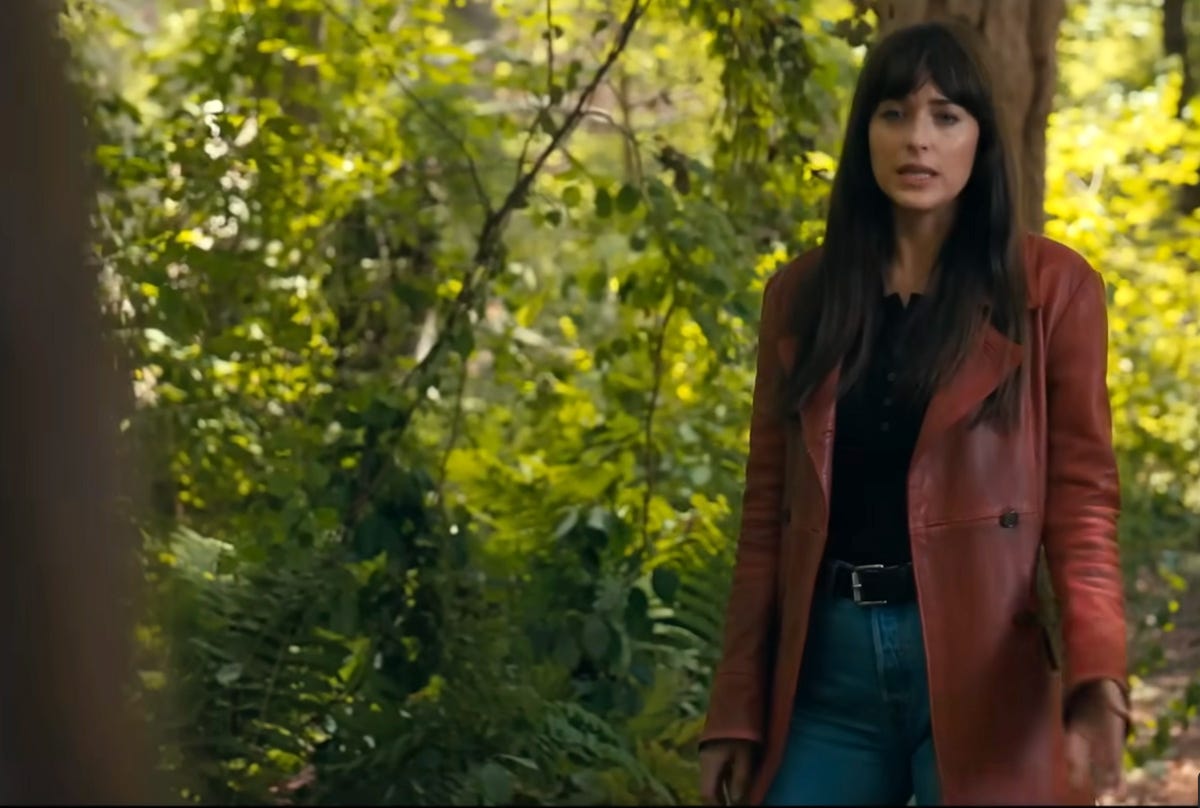'Madame Web' Is The Corporate Version Of 'The Room'
It may not be a good movie in the traditional sense, but it's as desperate and accidentally-revealing as Tommy Wiseau's cult classic.
Welcome to The #Content Report, a newsletter by Vince Mancini. I’ve been writing about movies, culture, and food since the aughts. Now I’m delivering it straight to you, with none of the autoplay videos, takeover ads, or chumboxes of the ad-ruined internet. Support my work and help me bring back the cool internet by subscribing, sharing, commenting, and keeping it real.
—
Once upon a time, The Room became a cult hit, not because of its fascinating plot or lively pacing, but because it was somehow both ineptly made and yet thoroughly revealing of the man who made it. Artists try to pour their guts out all the time, to varying levels of success. Yet when Tommy Wiseau, an eccentric immigrant desperate for acceptance, tried to make A Streetcar Named Desire and turn himself into the next Brando, he ended up instead with an unintentionally brutal self-examination, mostly through a combination of kismet and sheer incompetence. The Room is the kind of accidental or found art Dadaists dream of.
I’m here to tell you that Madame Web is basically that, only for a room full of corporate suits instead of a self-styled vampire wearing three belts. Rather than a guy with stringy hair and bloodshot eyes trying to convince you he’s from France through a thick Russian accent, it’s sweaty corporate lawyers trying to convince you that this movie was the plan all along through half-dubbed scenes plainly hacked together in post.
The film, part of Sony’s Spider-Man Universe that, through the complex architecture of licensing deals no longer includes Spider-Man, is a series of banalities that would be utterly imbecilic were it not so accidentally revealing. Almost every scene is like the fossil record of an idiotically arcane corporate struggle to get it on film. This is a movie called “Madame Web” with a main character whose name is “Webb.” Millions were spent after the fact to ensure that the movie matched an arbitrary fictional timeline (we’ll get to that soon) but thought it was fine to spell a name two different ways. Baffling. Convoluted. Pointless. It’s a snapshot of feckless corporate culture.
Madame Web isn’t good, in the traditional sense, but it is fascinating if you know what you’re looking for. You can’t watch it quite the way you would a “normal” movie, but I’m here to help. Like they say about jazz, a lot of the best parts of Madame Web are the scenes that didn’t make the final cut.
The Setting
Back in January, Jeff Sneider reported a rumor that Madame Web was originally supposed to be set in the 90s. This (according to the rumor) because it was mean to tie-in to the Andrew Garfield Spider-Man movies. Then, at some point, Sony decided it should tie-in to the Tom Holland Spider-Man movies instead, which changed the basic math of when the story should take place.
Now, bear with me… if Peter Parker is 16 years old in 2019’s Spider-Man: Far From Home, he would’ve been born in… 2003.
Is it a bad thing when the entire logic of your story rests on when a totally different movie takes place? Probably.
Indeed, Madame Web is explicitly set in 2003. And yet, throughout, there are ineffable signs of the original, mid-1990s setting, with occasional, overly explicit markers of 2003 crudely grafted over them.
The basic plot is that “Madame Web” (never referred to that way in this movie, despite the title), aka Cassandra Webb, played by Dakota Johnson, becomes the protector of three future spider-girls, who we see a few brief snippets of fighting crimes dressed as spiders, though only in dream sequences because they remain non-superpowered girls throughout the entirety of this movie. The three teenage Spider-Girls in waiting are played by Sydney Sweeney, Isabela Merced, and Celeste O’Connor. In one scene, the girls dance to Britney Spears’ “Toxic” on top of a table at a diner.
There’s a radio DJ telling us “this song’s gonna be huge!” and one of the girls telling another, who’s late to the table dance, “don’t pretend you’re better than Britney Spears!”
Tellingly, we don’t actually see the speaking character’s lips during this shot. It’s a weird, kind of boring scene on the face of it — teenage girls blowing their cover by dancing on a diner table in an attempt to impress some boys — but trying to imagine what song they were actually dancing to adds a layer of intrigue.
In another scene, Cassandra Webb tells her EMT partner, played by Adam Scott, “I gotta get home to watch ‘Idol.’”
Sure, Cassandra, sure. American Idol was maybe the first thing the studio thought of when they thought of 2003, but when I think of 2003, the first thing I think of is trucker hats, bleachy blonde fried hair, overtweezed eyebrows, over-tanned skin, and crucially, when your protagonists are female, really low-rise pants (which women seem to universally hate now, but part of me still likes because their popularity coincides with my personal sexual awakening).
2003 in pop culture and styling is basically this picture of Christina Aguilera. Meanwhile, Dakota Johnson (decidedly dark-haired and pale-skinned, with normal eyebrows) spends most of the movie dressed like this:
Someone might have worn that outfit in 2003, but no costume designer who was trying to evoke 2003 would’ve chosen it. Those pants look like high-ish rise blue denim with a sorta chunky black leather belt and a lightly-padded jacket. I’m not a fashion historian, but that looks to me like a Courtney Cox fit circa 1993-1996.
Meanwhile, aside from the line about “Idol” and the Britney Spears scene, the film’s other needle drops include “Dreams,” by The Cranberries (1993), a brief strain from “What’s Up,” by 4-Non Blondes (1993), and “Bitch,” by Meredith Brooks (1997).
Again, this evokes a whole other corporate battle going on behind the scenes. They’re needle drops, they could’ve just replaced them with other songs! Of course, those other songs cost money, and the 90s songs were presumably already paid for — plus it’s entirely plausible that people would still be listening to 90s songs in 2003. The internal logic of is it is less interesting than the fact that there were probably at least three heated Zoom meetings debating this.
Meanwhile, the spider trio, all 20-somethings playing teenagers, are much harder to pin down, chronologically — with Sydney Sweeney dressed like a parody of a demure Catholic schoolgirl, Celeste O’Connor in punky bare midriffs showing off Calvin Klein underwear (which again seems more 90s than 2003), and Isabel Merced in an “I Eat Math for Breakfast” logo tee (her character is the brainy one, obviously).
I found myself weirdly fascinated, scanning the clothes, styling, and background information for context clues like a game of Where’s Waldo, even while the characters were delivering the world’s most leaden clunkers in service of a stinker plot as part of a commercial scheme that was probably doomed before the cameras ever started rolling.
Marvel’s Eternals already showed us that audiences don’t care about comic book characters this ancillary no matter how much work you put in trying to tie them into a more popular story. And that was Marvel, a company that’s historically been a lot more competent at this sort of thing that Sony (even though I personally greatly prefer the Sony ouvre to the Marvel).
The setting is such a compelling mystery in in Madame Web that you’re essentially scanning an anachronism for anachronisms.
Does Dakota Johnson Drink Pepsi?
Another obvious bit of subtext for Madame Web, even easier to infer than the setting swap, is that it must’ve been sponsored by Pepsi. Pepsi-Cola logos appear at least five times during the film and the finale sequence takes place underneath a giant, neon Pepsi-Cola sign, with the falling letters dodged, climbed, and used as weapons and shields. It is… not-subtle.
Meanwhile, Dakota Johnson is handed Pepsi products in two separate scenes and neither time does she actually drink it. In fact, the un-subtlety with which she pointedly does not drink this soda rivals the un-subtlety of the product placement itself. The Room viewers famously shouted “spoon!” every time a spoon appeared on screen (apparently the result of the set designer buying picture frames without replacing the stock photos inside them), but Madame Web’s Pepsi scenes are arguably even more perversely entertaining.





